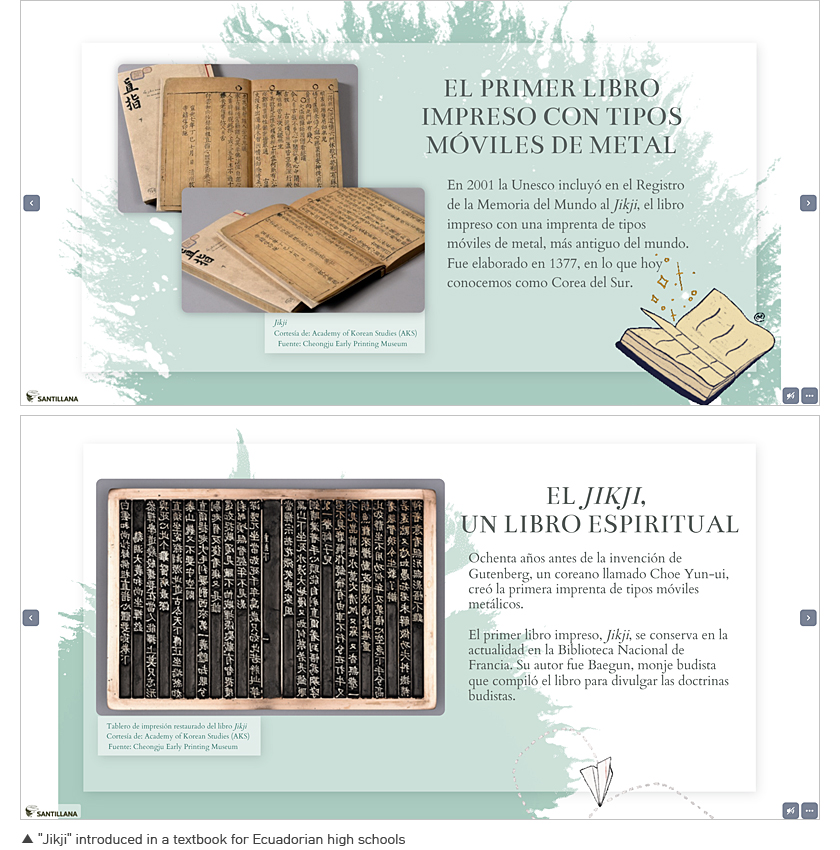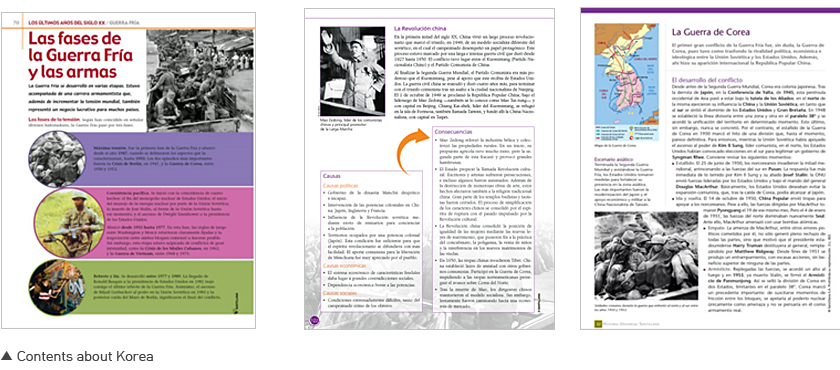Column
How Did Korea's Jikji End Up in an Ecuadorian Textbook?
What is Jikji?
Jikji is the world's oldest book printed with metal type, compiled by the monk Baekwoon. It was published in Korea in 1377 using metal type printing technology. The inclusion of Jikji in an Ecuadorian textbook began through a process that started 10 years ago. The starting point was when an author from Santillana Publishing, responsible for research and development of social sciences content, was invited to visit Korea. The trip served as an opportunity for the writer to discover new perspectives and to break away from a Eurocentric view of world history, as well as to challenge many previously held preconceptions.The Author's Perspectives Prior to the Visit to Korea
World history can be divided into two distinct phases: before and after the invention of writing. After writing was invented, the ancient civilizations of the Egyptians, Greeks, and Romans emerged, characterized by their high levels of culture and intelligence. During this period, many eminent philosophers like Aristotle, Plato, and Socrates appeared. Toward the end of the ancient era, the Germanic invasions took place, resulting in a large portion of the population relocating to rural areas. This era was marked by the rise of feudalism, the influence of the Catholic Church, limited social mobility, and the predominance of agriculture. During this time, friars were responsible for copying and creating ancient manuscripts, while the general population remained largely illiterate and uninformed.The Renaissance was a transitional period between the Middle Ages and the modern era, characterized by an awakening of knowledge, a re-adoption of the values of ancient philosophers, the discovery of the Americas, the development of banking and commerce, and the invention of the Gutenberg printing press around 1440. Until the mid-15th century, knowledge in Europe was disseminated through manuscripts prepared by friars. The invention of the printing press drastically accelerated the copying process. Within a few years, the wider dissemination of knowledge and reduced production costs allowed writings to be published for a much broader audience. The European approach to understanding history became widely accepted in the West and served as a foundational aspect of how history was conceptualized.
Traveling to Korea - Discovery
In 2013, a trip to South Korea was organized by the Academy of Korean Studies to facilitate cultural exchange between various Ecuadorian publishing houses. Gaby Rodríguez, an author specializing in social sciences content, represented Santillana Publishing on this trip. Toward the end of the visit, she had the opportunity to explore the National Museum of Korea. During this visit, she was amazed to discover that the invention of movable type, used to print the world's oldest books, had occurred in Korea in the 14th century—several years before Gutenberg invented his printing press. This discovery led to a divergence from the European historical data she had been assimilating and learning.A few years later, in 2020, Santillana Publishing broadened its operational vision through an interdisciplinary approach, strengthening collaborations among authors from various academic fields. In 2021, authors in the social sciences were prompted to extend their expertise into the literary domain and were encouraged to write textbooks. One of the topics covered in the country's high school language and literature textbooks was the invention of the printing press and its impact. The information she had learned in Korea years earlier was not only adopted but also enhanced through more comprehensive research. Considering that the information to be presented represented a departure from what had been previously disseminated in educational texts, a credible source was needed to support this new knowledge in case of public skepticism or backlash.
Further research on the letterpress revealed that a book titled 'Jikji,' published in 1377, was produced using this printing technique. The book was designated as a World Heritage Document by UNESCO, underscoring its importance and historical significance. Meanwhile, there was a need to develop educational digital resources to support and enrich learning on this topic. To achieve this, ample illustrative content such as photographs and illustrations was needed to enhance the digital presentation. To source these materials, a request was made to Park Hye-jeong, the Latin America Coordinator at the Academy of Korean Studies . The Academy generously provided valuable resources for the creation of the digital materials.

Contents about Korea Included in Ecuadorian Textbooks
While the Ecuadorian curriculum does not explicitly feature Korean topics, a variety of themes related to different facets of Korean culture and history are nonetheless covered in diverse Ecuadorian textbooks and current interdisciplinary projects.The primary topics that include Korean-related content are as follows:
• Colonial Imperialism: Covers maps related to international conflicts that occurred in the last century.
• Japanese Expansion during World War II: Examines cases illustrating how Japan engaged in imperialist actions.
• Partition of Asia: Territories that Japan wished to annex and areas in conflict with China.
• Sino-Japanese Dispute over Korean Territory: Territories in dispute between China and Japan.
• The Cold War: The inception of the Korean War.
• Chinese Intervention to Aid North Korea: Discusses China's involvement to support North Korea.
• The Korean War (Development of the Conflict): Explores the unfolding of the Korean War.
• Korea as an Example of Cultural Diversity: Highlights Korean culture as a case study in cultural diversity.
• Korea as an Example of Healthy Eating Based on Fermentation: Features Korean dietary practices centered on fermentation.


